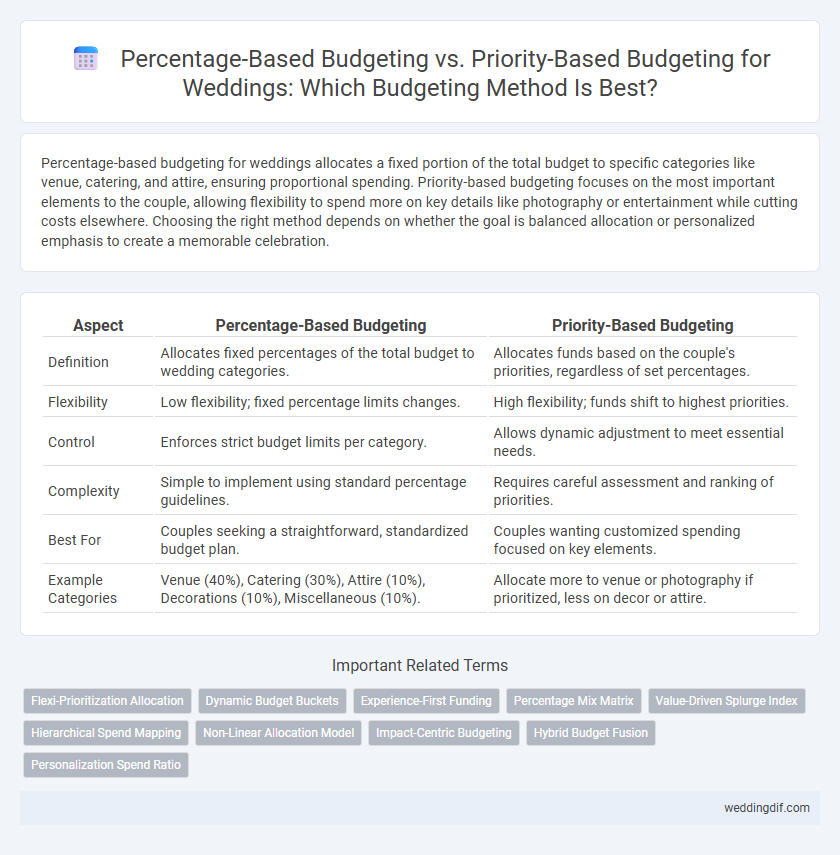Percentage-based budgeting for weddings allocates a fixed portion of the total budget to specific categories like venue, catering, and attire, ensuring proportional spending. Priority-based budgeting focuses on the most important elements to the couple, allowing flexibility to spend more on key details like photography or entertainment while cutting costs elsewhere. Choosing the right method depends on whether the goal is balanced allocation or personalized emphasis to create a memorable celebration.
Table of Comparison
| Aspect | Percentage-Based Budgeting | Priority-Based Budgeting |
|---|---|---|
| Definition | Allocates fixed percentages of the total budget to wedding categories. | Allocates funds based on the couple's priorities, regardless of set percentages. |
| Flexibility | Low flexibility; fixed percentage limits changes. | High flexibility; funds shift to highest priorities. |
| Control | Enforces strict budget limits per category. | Allows dynamic adjustment to meet essential needs. |
| Complexity | Simple to implement using standard percentage guidelines. | Requires careful assessment and ranking of priorities. |
| Best For | Couples seeking a straightforward, standardized budget plan. | Couples wanting customized spending focused on key elements. |
| Example Categories | Venue (40%), Catering (30%), Attire (10%), Decorations (10%), Miscellaneous (10%). | Allocate more to venue or photography if prioritized, less on decor or attire. |
Introduction to Wedding Budgeting Methods
Percentage-based budgeting allocates a fixed portion of the total wedding budget to each category, such as 40% for the venue, 20% for catering, and 15% for attire, offering a clear structure for cost distribution. Priority-based budgeting focuses on allocating more funds to high-priority elements chosen by the couple, allowing flexibility and personalized spending based on what matters most to them. Understanding these methods helps couples manage expenses effectively while aligning spending with their wedding vision.
What is Percentage-Based Wedding Budgeting?
Percentage-based wedding budgeting allocates specific portions of the total budget to predefined categories such as venue, catering, attire, and decorations, typically expressed as percentages like 40% for venue and 20% for catering. This method provides a clear financial framework that helps couples manage expenses proportionally according to the importance of each element. By assigning fixed percentage limits, it ensures balanced spending, reduces overspending risks, and simplifies decision-making throughout the wedding planning process.
What is Priority-Based Wedding Budgeting?
Priority-based wedding budgeting allocates funds according to the couple's most important aspects, such as venue, catering, or photography, rather than fixed percentages. This approach ensures that key elements receive sufficient investment to reflect personal values and preferences. It offers flexibility and customization, allowing couples to align their spending with what matters most for their special day.
Pros and Cons of Percentage-Based Budgeting
Percentage-based budgeting for weddings allocates fixed proportions of the total budget to key categories such as venue, catering, attire, and entertainment, ensuring a balanced distribution of funds that aligns with industry standards. This method simplifies financial planning and offers clarity, but may lack flexibility to accommodate unique priorities or unexpected expenses, potentially limiting a couple's ability to customize their celebration fully. Rigid adherence to percentages can lead to overspending in less important areas or underspending in critical ones, making it less ideal for highly personalized wedding experiences.
Pros and Cons of Priority-Based Budgeting
Priority-based budgeting for weddings allows couples to allocate funds according to what aspects matter most, such as venue, attire, or entertainment, ensuring a tailored and meaningful celebration experience. This method provides flexibility and personal satisfaction but may lead to overspending in prioritized areas while neglecting less emphasized components. Compared to percentage-based budgeting, it demands careful tracking and discipline to avoid imbalanced allocations that could impact the overall wedding day quality.
Key Differences Between the Two Approaches
Percentage-based budgeting allocates fixed portions of the total wedding budget to categories like venue, catering, and attire, ensuring proportional spending aligned with overall costs. Priority-based budgeting, however, focuses on allocating more funds to the most important elements of the wedding, such as the ceremony or photography, allowing flexibility in less critical areas. The key difference lies in percentage-based budgeting's structured distribution versus priority-based budgeting's emphasis on personal preferences and customized spending.
Choosing the Right Budgeting Method for Your Wedding
Choosing the right budgeting method for your wedding depends on your financial priorities and flexibility. Percentage-based budgeting allocates fixed portions of your total budget to categories like venue, catering, and attire, ensuring balanced spending. Priority-based budgeting allows couples to focus resources on the most important elements, such as photography or entertainment, optimizing satisfaction within financial limits.
Practical Steps for Implementing Percentage-Based Budgeting
Allocating specific percentages of the total wedding budget to categories like venue, catering, attire, and entertainment streamlines financial planning and ensures balanced spending. Begin by determining the total budget, then assign percentage caps based on typical expense benchmarks (e.g., 40% for venue and catering, 20% for attire, 15% for entertainment). Regularly track expenditures against these percentage allocations using budgeting software or spreadsheets to stay on target and adjust categories as needed.
Practical Steps for Implementing Priority-Based Budgeting
Implementing priority-based budgeting for weddings begins with listing and ranking key elements such as venue, catering, and attire according to personal significance. Allocate funds first to high-priority categories, ensuring essential aspects meet expectations before distributing remaining budget to secondary items. Regularly review and adjust allocations to stay aligned with evolving preferences and vendor negotiations.
Final Tips for Effective Wedding Budget Management
Allocate specific percentages of the total wedding budget to crucial categories such as venue, catering, and attire for balanced percentage-based budgeting. Prioritize essential elements like guest experience and key moments when using priority-based budgeting to enhance overall satisfaction. Regularly review and adjust your budget allocations to prevent overspending and ensure alignment with your wedding vision.
Percentage-Based Budgeting vs Priority-Based Budgeting for weddings. Infographic

 weddingdif.com
weddingdif.com